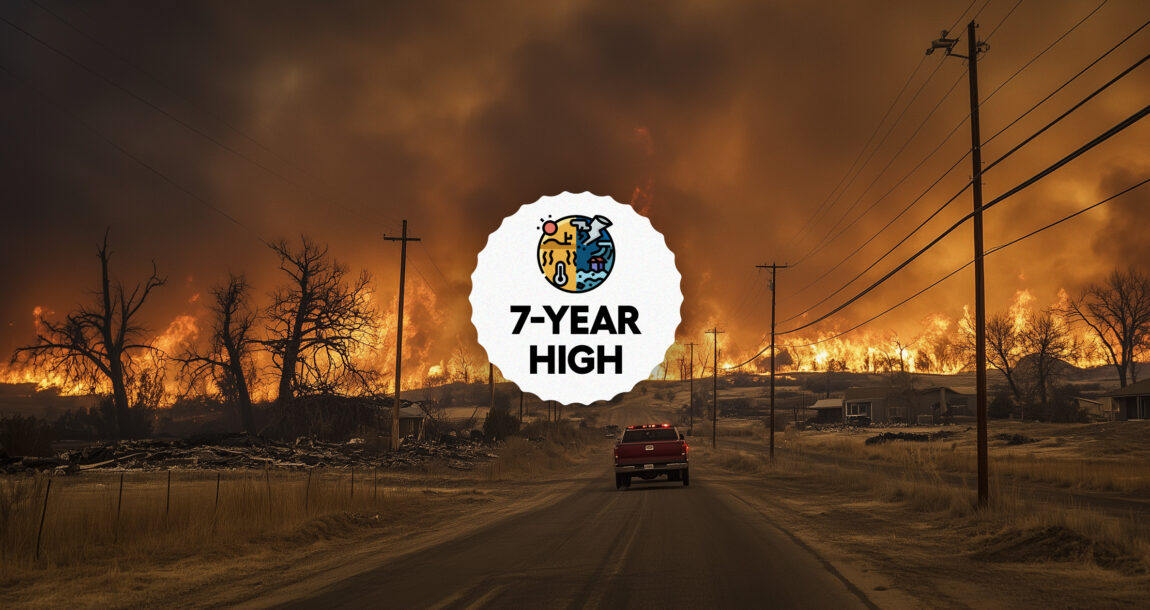US catastrophe claims hit 7-year high, report finds

Catastrophe claims related to severe weather events accounted for just under half of all perils in 2023, according to the latest Home Trends report released by data analytics firm LexisNexis.
This is the highest number of catastrophe claims in the last seven years, reflecting the increasing risks brought on by climate change.
“Every region in the country has different types of catastrophic events, with the overall result that as more of these occur, the lost dollars go up — and it isn’t just hurricanes. It’s really a variety of type of catastrophic events,” Kelly Rush, director of home insurance, LexisNexis Risk Solutions, said.
LexisNexis found that high inflation, high loss cost and increasingly high average severity are driving home insurance premiums up, particularly in states vulnerable to severe weather events like Florida and California.
However, Rush said carriers are increasingly interested in using data to stay on top of trends such as catastrophe claims and find new, creative ways to resolve losses without leaving the market entirely.
Catastrophe claims: Increasing loss costs
The LexisNexis 2024 Home Trends report assessed claims between 2017 and 2023 and found that loss cost for all perils has been on a steady rise. In 2013, it jumped an enormous 51.7% from 2019, while average severity increased by nearly 30%.
Looking at specific perils, loss cost for hail saw the only increase between 2022 and 2023, increasing by 58%. Loss cost for fire and lightning, weather-related and non-weather-related all decreased by 11%, 51% and 11% respectively.
Home insurers were cautioned not to rely on short-term trends, however, as they can fluctuate due to seasonal variability. For instance, 2023’s decrease in weather-related peril — which includes hurricanes, floods and wind — was referred to as a “short-term reprieve” for carriers, given that these risks are trending upwards overall.
Insurers may not be so fortunate this year. Moody’s has already estimated private losses from Hurricane Helene in September and Hurricane Milton in October to reach as much as $36 billion — and there’s still another month to go before this above-average Atlantic hurricane season is set to end.
What’s driving costs up?
Rush noted that it’s not just an increase in extreme weather events and catastrophe claims, but also a trend of high inflation that’s driving loss costs higher.
“Mostly, what we see is the costs have gone up from inflation, and then the costs are also going up because of the increase in overall catastrophic events. What the industry is seeing is that the frequency of high-dollar catastrophic events is driving a large portion of their overall losses that are getting paid out,” he explained.
This results in a higher average severity, which has “jumped dramatically” over the last five years.
“That’s driving a lot of the overall insurance, home insurance loss increases that are being paid out in the country over the last five years,” Rush added.
Carriers seek solutions
There has been concern that the increasing loss costs could drive home insurers out of high-risk markets in the United States, but Rush said LexisNexis has found that those carriers are far and few in between.
“What we’ve been hearing more of, actually, is carriers want to solve for this. They don’t necessarily want to stop writing business as a general rule, and what they’re trying to do is just better understand the risk,” he said.
When carriers are better able to understand the risk, it enables them to better negotiate and also offer consumers advice. For example, they may suggest clients add storm shutters to help with hurricane damages or consider a different type of foliage around their home to help avoid wildfires.
“Also, carriers have been asking for more information, more data in general, because it isn’t just catastrophic events. If carriers can manage the non-catastrophic events, then they can weather the catastrophic events easier… The industry, as a whole, seems to just be trying to find other data-driven solutions to better understand the risks,” Rush said.
Shifting focus with shifting trends
An additional factor insurers were urged to keep in mind as they seek ways to resolve losses is that trends related to perils have shifted. Rush suggested carriers may want to consider shifting their focus accordingly even as they use actuarial data, standard forecasting models and other tools for their predictions.
“The perils that were important in the past have shifted… What we’ve been seeing in our data, and we’ve also been hearing this from our customers, is they want to be able to change their focus as these trends occur. They don’t want to focus on what was important 20 years ago; they want to be ahead of that and predict [when a] type of loss is becoming more important,” Rush said.
This is where carriers could consider using AI, LexisNexis suggested, as their own internal data may be limiting while an industry-wide dataset may generate more specific insights.
LexisNexis is an American data analytics company based in New York and founded in 1970. The 2024 HomeTrends report assessed LexisNexis internal data collected from about 90 million households throughout the United States between 2017 and 2023.
© Entire contents copyright 2024 by InsuranceNewsNet.com Inc. All rights reserved. No part of this article may be reprinted without the expressed written consent from InsuranceNewsNet.com.
Rayne Morgan is a journalist, copywriter, and editor with over 10 years' combined experience in digital content and print media. You can reach her at [email protected].






Survey finds some support for DOL fiduciary rule
Insurance agency M&A activity down 10% through Q3, Optis reports
Advisor News
- Private equity, crypto and the risks retirees can’t ignore
- Will Trump accounts lead to a financial boon? Experts differ on impact
- Helping clients up the impact of their charitable giving with a DAF
- 3 tax planning strategies under One Big Beautiful Bill
- Gen X’s retirement readiness is threatened
More Advisor NewsAnnuity News
- LTC annuities and minimizing opportunity cost
- Venerable Announces Head of Flow Reinsurance
- 3 tax planning strategies under One Big Beautiful Bill
- MetLife Completes $10 Billion Variable Annuity Risk Transfer Transaction
- Gen X’s retirement readiness is threatened
More Annuity NewsHealth/Employee Benefits News
Life Insurance News
- On the Move: Dec. 4, 2025
- Judge approves PHL Variable plan; could reduce benefits by up to $4.1B
- Seritage Growth Properties Makes $20 Million Loan Prepayment
- AM Best Revises Outlooks to Negative for Kansas City Life Insurance Company; Downgrades Credit Ratings of Grange Life Insurance Company; Revises Issuer Credit Rating Outlook to Negative for Old American Insurance Company
- AM Best Affirms Credit Ratings of Bao Minh Insurance Corporation
More Life Insurance News